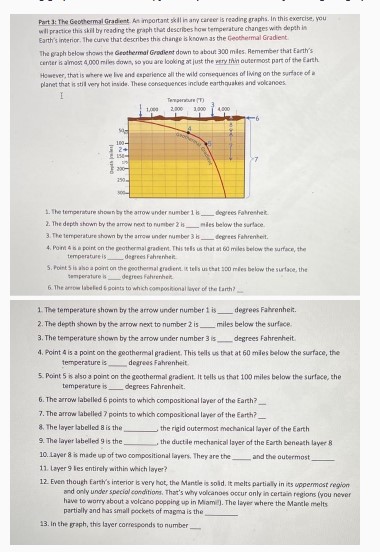QQuestionAnatomy and Physiology
QuestionAnatomy and Physiology
Part 3: The Geothermal Gradient. An exporiject skill in any career is reading graphi. In this exercise, you will practice this skill by reading the graph that describes how temperature changes with depth in Earth's interior. The curve that describes this change is known as the Geothermal Gradient.
The graph below shows the Geothermal Gradient down to about 300 miles. Remember that Earth's center is almost 4,000 miles down, so you are looking at just the very thin eatermost part of the Earth.
However, that is where we live and experience all the wild consequences of living on the surface of a planet that is still very hot inside. These consequences include earthquakes and volcanoes.
1. The temperature shown by the arrow under number 1 is _____ degrees Fahrenheit.
2. The depth shown by the arrow next to number 2 is _____ miles below the surface.
3. The temperature shown by the arrow under number 3 is _____ degrees Fahrenheit.
4. Point 4 is a point on the geothermal gradient. This tells us that at 60 miles below the surface, the temperature is _____ degrees Fahrenheit.
5. Point 5 is also a point on the geothermal gradient. It tells us that 100 miles below the surface, the temperature is _____ degrees Fahrenheit.
6. The arrow labelled 6 points to which compositional layer of the Earth? _____
1. The temperature shown by the arrow under number 1 is _____ degrees Fahrenheit.
2. The depth shown by the arrow next to number 2 is _____ miles below the surface.
3. The temperature shown by the arrow under number 3 is _____ degrees Fahrenheit.
4. Point 4 is a point on the geothermal gradient. This tells us that at 60 miles below the surface, the temperature is _____ degrees Fahrenheit.
5. Point 5 is also a point on the geothermal gradient. It tells us that 100 miles below the surface, the temperature is _____ degrees Fahrenheit.
6. The arrow labelled 6 points to which compositional layer of the Earth? _____
7. The arrow labelled 7 points to which compositional layer of the Earth? _____
8. The layer labelled 8 is the _________ the rigid eutermost mechanical layer of the Earth.
9. The layer labelled 9 is the _________ the ductile mechanical layer of the Earth beneath layer 8.
10. Layer 8 is made up of two compositional layers. They are the _____ and the eutermost _____.
11. Layer 9 lies entirely within which layer? _____
12. Funn though Earth's interior is very hot, the Munde is solid. It malls partially in its uppermost region and only under special conditions. That's why volcanoes occur only in certain regions (you never have to worry about a volcano popping up in Miami!). The layer where the Munde malls partially and has small pockets of magma is the _________.
13. In the graph, this layer corresponds to number _____.
Attachments

6 months agoReport content
Answer
Full Solution Locked
Sign in to view the complete step-by-step solution and unlock all study resources.
Step 1I'll solve this problem step by step, carefully following the LaTeX formatting guidelines:
Step 2: Analyzing Point 1
- The temperature at point 1 is $$200$$ degrees Fahrenheit.
Final Answer
1. 200 °F 2. 20 miles 3. 400 °F 4. 800 °F 5. 1,200 °F 6. Asthenosphere 7. Lithosphere 8. Lithosphere 9. Asthenosphere 10. Crust, Mantle 11. Mantle 12. Asthenosphere 13. 9
Need Help with Homework?
Stuck on a difficult problem? We've got you covered:
- Post your question or upload an image
- Get instant step-by-step solutions
- Learn from our AI and community of students